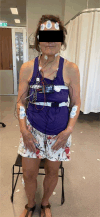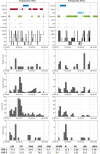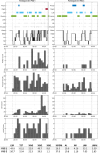Sleep disruption and sleep position: Increased wake frequency in supine predicts lateral position preference
- PMID: 39191505
- PMCID: PMC11744251
- DOI: 10.1111/jsr.14325
Sleep disruption and sleep position: Increased wake frequency in supine predicts lateral position preference
Abstract
Little is known about the physiological and biomechanical factors that determine individual preferences in lying posture during sleep. This study investigated relationships between position preference and position-specific arousals, awakenings, limb movements and limb movement arousals to explore the mechanisms by which biomechanical factors influence position preference. Forty-one mature-aged adults underwent 2 nights of at-home polysomnography ~2 weeks apart, on a standardised firm foam mattress, measuring nocturnal sleep architecture and position. The lateral supine ratio and restlessness indices specific to lateral and supine positions including limb movement index, limb movement arousal index, arousal index, wake index, respiratory arousal index and apnea-hypopnea index were calculated and analysed via linear mixed-effects regression. In the supine position, all restlessness indices were significantly increased compared with the lateral position, including a 379% increase in respiratory arousals (β = 7.0, p < 0.001), 108% increase in arousal index (β = 10.3, p < 0.001) and 107% increase in wake index (β = 2.5, p < 0.001). Wake index in the supine position increased significantly with more lateral sleep (β = 1.9, p = 0.0013), and significant correlation between lateral supine ratio polysomnography 1 and lateral supine ratio polysomnography 2 (β = 0.95, p < 0.001) indicated strong consistency in sleep preference. Overall, the findings suggest that some individuals have low tolerance to supine posture, represented by a comparatively high wake index in the supine position, and that these individuals compensate by sleeping a greater proportion in the lateral position.
Keywords: arousals; awakenings; lateral position; positional therapy; sleep; sleep apnea; sleep position; sleep posture; supine position.
© 2024 The Author(s). Journal of Sleep Research published by John Wiley & Sons Ltd on behalf of European Sleep Research Society.
Conflict of interest statement
The authors acknowledge the research support provided by Sealy Australia. This support has provided: salary for Dr Lionel Rayward, A/ Prof. Paige Little and Ms Selina W. K Ho. Research datasets for healthy adults (including PSG data).
Figures





References
-
- Abanobi, O. C. , Ayeni, G. O. , Ezeugwu, C. C. , & Ayeni, O. A. (2015). Risk‐disposing habits of Lowback pain amongst welders and panel beaters in Owerri, South‐East Nigeria. Indian Journal of Public Health, 6(3), 187. 10.5958/0976-5506.2015.00164.3 - DOI
-
- Babisch, W. , Ising, H. , Gallacher, J. E. J. , Sweetnam, P. M. , & Elwood, P. C. (1999). Traffic noise and cardiovascular risk: The Caerphilly and speedwell studies, third Phase‐10‐year follow up. Archives of Environmental Health: An International Journal, 54(3), 210–216. 10.1080/00039899909602261 - DOI - PubMed
-
- Berry, R. B. (2012). The AASM manual for the scoring of sleep and associated events: Rules, terminology and technical specifications, version 2.0. American Academy of Sleep Medicine.
Publication types
MeSH terms
LinkOut - more resources
Full Text Sources
Medical

